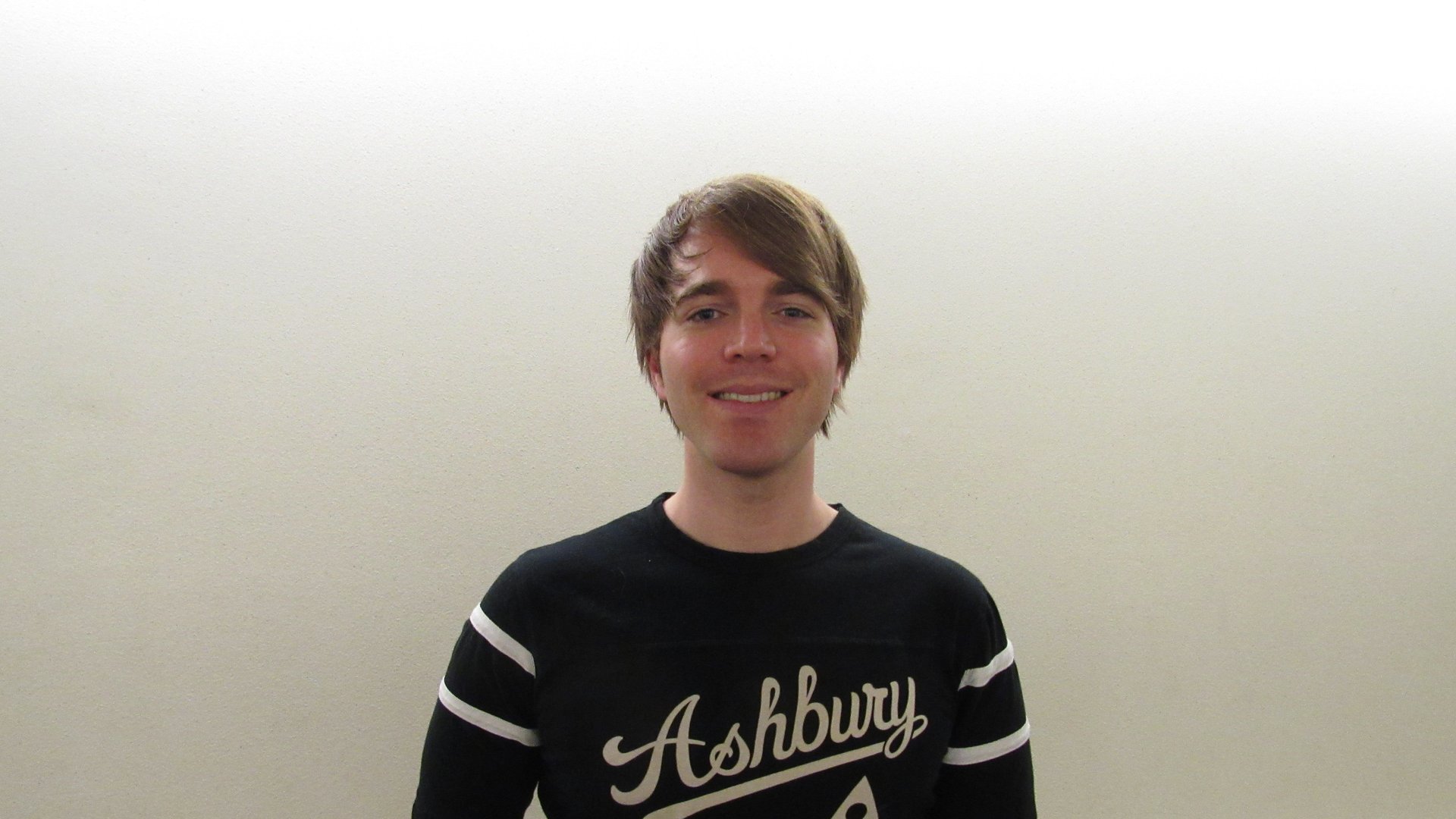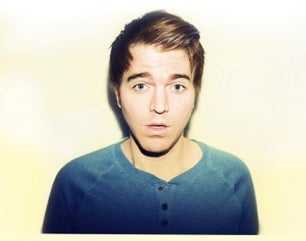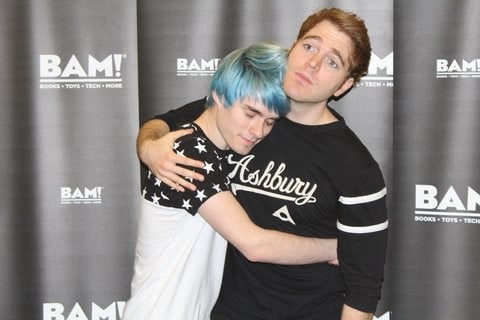Shane Dawson: The most popular, successful, comedian you’ve never heard of
“I just wanted to make movies,” Shane Dawson says of his unlikely fortune as a YouTube sensation. “I’d wanted to be a director since I was five, and had been making videos since I was a kid. Then YouTube came around during high school. I was making videos and it was just a place to put them, like storage.”


“I just wanted to make movies,” Shane Dawson says of his unlikely fortune as a YouTube sensation. “I’d wanted to be a director since I was five, and had been making videos since I was a kid. Then YouTube came around during high school. I was making videos and it was just a place to put them, like storage.”
That was in 2008. 12 million YouTube subscribers, a film (2014’s Not Cool), a hugely successful, trendsetting podcast, and a best selling book (this year’s I Hate Myselfie) later, and Dawson is remarkably the elder statesman of a standing-room-only BookCon panel that features fellow YouTube stars-turned-authors Joey Graceffa, Connor Franta, and Justine Ezraik. But he’s still the Shane Dawson that his legion of devoted fans adore. Warm, funny, open, honest to a fault, and clearly ambitious.

“I haven’t slept,” Dawson says, as we begin our interview, seemingly to both excuse the scattered nature of his rapid-fire answers and as a way to instantly endear himself. “I didn’t sleep last night. Up on stage I had one of those out of body experiences. I’m so sick right now. I’m going to get every kid sick. I know, I’m just blabbering.”
It’s easy to dismiss YouTube and its stars as anything but the juggernaut it’s become. Most of us use it to watch news clips, conveniently hear our favorite music (sorry Tidal), or just to pass the time at work, the way we used to spend evenings channel-surfing. But to at least a generation, YouTube is its own ecosystem, with stars as big as any in movies or on television.
“YouTube has a stigma about only kids watching it,” Dawson explains. “That’s true. It is mostly kids and teenagers who watch it. But I’ve never made videos for teenagers. They should not be watching my videos. They’re not for them. But that’s the medium, that’s who’s watching.”
And part of Dawson’s appeal to his audience is the “I’m doing this for me” attitude, that comes across as authenticity in a world full of inauthentic messages.
“I wanted to make movies, and YouTube was the place for me to learn how to make movies and eventually make one,” Dawson elaborates on how he came to YouTube, and what he tells his fans who want to follow in his footsteps. “A lot of people want to be advocates or whatnot. If you just want to go into it to be a public YouTuber, the shelf life for that is about two and a half years. Most YouTubers last two and a half years. What are you going to do after that? I think writing books is interesting. And I think a lot of these YouTubers want to be authors, and that is a longer career. But who’s going to buy your books if you’re not getting views on YouTube? So for that kid in the audience who asks for real advice about how to do this, is to figure out why you want to be a YouTuber and where you want it to lead you. Don’t just do daily vlogs (video blogs) and stuff. If that’s the goal, what’s going to end up happening in your daily life won’t be interesting anymore. To be successful you’ve got to have something interesting to say. You’ve got to have an interesting perspective to what you do in your life.”
After a pause, Dawson hits on another thought.
“You’ve also got to make good shit,” he says flatly. “You can’t put up videos that suck. A lot of people complain, ‘Oh, how come nobody’s watching my videos?’ Because they suck! My videos sucked back in the day. But very few people were watching.”
Dawson first came to YouTube in 2008, when there was no such thing as a YouTube star—and, as a result, the stakes were relatively low. He didn’t see it as a career path at the time, because, really, it wasn’t.
“Around 2008, I had lost all this weight and I wanted to be an actor,” he recalls. “ I thought, ‘That will be my way into making movies.’ I started auditioning, but I didn’t get anything. I was hanging out on YouTube, and I realized, ‘Wait a minute, why not start my own show on YouTube?’ I saw a couple of other people were doing it. So I just did it. I uploaded my first video in 2008 on a channel I created, Shane Dawson TV. My plan was to make weekly videos in the hopes that maybe people would watch them. They did.”
Dawson makes it sound simple, but he hit on something that struck a nerve in a generation of what would be his core fans. From that first vlog back in 2008, to his full-length film directorial debut for Not Cool last year, Dawson has been an open book when documenting his life. Along the way, his more than 12 million YouTube followers have witnessed awkward and adorable moments of his home life that most of us would never dream of sharing—raunchy sex tape spoofs, excruciatingly detailed love life details, haircut reveals, and his simultaneously insightful and vulgar commentary on everything that celebrity culture and the internet have dished out over the past seven years.

“I think everybody around me believed in me because, even though I’m a very negative person, and I’ve felt a lot of doubt about everything else throughout my life, this was one thing where I believed in myself completely. I kept saying, ‘I’m going to make movies. I’m going to do that.’ I’m not sure I believed in me at that point, but I think everybody around me believed in me, and that helped push me forward.”
It was also almost instantly rewarding financially.
“A good year, obviously, was back in 2009, when there were less people on YouTube,” Dawson says of the money he’s earned via YouTube. “Now there are so many people that are partnered, where the ads spread super far. But back then I could get $10 for a thousand views. Now it’s pushing a dollar or two dollars for that same amount. And you never know. YouTube changes every year. They change their algorithm, their advertising. Some years you could make no money, and some years you could make great money. It can go really up and down, and that’s why a lot of YouTubers are trying to find different ways to make money—podcasting, books, music, movies—trying to find other things to support themselves. Also, YouTube has flagged a lot of my videos (as inappropriate for advertising), which means people can’t put ads on them, because they’re too risqué. And they’ve deleted some. I’ve definitely had a lot of hardship on the website. But luckily, now I get 45 million views per month or thereabouts, so that makes up for it. Back around 2009 I only had about 20 million views each month, because I only had one channel and I was doing one video a week. Now I do nine videos a week. You’ve got to evolve.”
That evolution has included the best-selling book, I Hate My Selfie, a successful podcast called “Shane and Friends,” and Dawson’s directorial debut via last year’s Not Cool.
“YouTube is probably about 25% of my income now,” Dawson explains. “I wanted to make sure I had other sources coming through because it’s so unreliable sometimes. So I made a movie—which I’ve obviously always wanted to do—and found out the process of not just making a movie but of funding and release and distribution. And I quickly learned that there’s no money in movies right now, unless you’re Steven Spielberg. But I don’t want to have to direct some movie just for the paycheck. I just want to make movies that I enjoy, and I did and I hope I can again.
“The podcast is something—it’s not really underground, because it gets a lot of listens—but it’s something that I really love,” Dawson says of the hugely popular “Shane & Friends.” “Howard Stern is one of my idols. I love interviewing people and getting them to talk about things they’ve never talk about. I’ve been doing that for a couple years. I would love to keep doing that and film it, too.
“And when I wrote a book, I wanted to write a book for people my age, for adults, that anybody would like, but that I could be proud of,” Dawson continues. “Hopefully my audience will buy it, and people outside of my audience will buy it, but I know it’s hard to expand your audience on YouTube. I’m glad it’s been successful, but for me it’s great that there are all these other ways to make income, not just from YouTube, but from my podcast, and now books. These are all things I enjoy, so it’s awesome. Everything I’m doing and am passionate about also creates income. That’s amazing. But it’s a way to support myself so that I can eventually make more movies.
“My plan is not to kill myself and not to die,” he says. “When I graduated high school, I made a plan. I couldn’t afford college. I wanted to lose the weight. I lost 200 pounds in six months. I wanted to make the YouTube videos. I started a channel and made weekly videos. In five years, I wanted to make a movie. I did that. I directed a movie. Five years from now I want to direct another movie that I’m not starring in. That’s my goal. Ten years from now I’ll hopefully be going the Kevin Smith route, just directing and using YouTube as a way to market the movies.”
So does Dawson have YouTube figured out?
“It’s easy and hard,” he says, honest to a fault. “It’s easy, in a way, because I’ve got it down to a science. I’ll stockpile; I’ll film ten videos in an hour. I’ll just knock them out, change shirts, and improv the whole day. The hard part is it makes it harder for me to get inspired to do the bigger projects, the short films or music videos or whatever. Those are draining, and they’re expensive, because I fund everything myself. I don’t have a studio. So yes, it’s easier because I’ve gotten it down to a science, but it’s harder because the inspiration is harder to come by. But I’m a planner. I always think everything’s going to end tomorrow. That keeps me going.”
Like his hero Howard Stern did when he appeared on the Late Show with David Letterman, Dawson is adept at turning the questions around, catching me off-guard.
“You know, you asked a question that nobody ever asks, and I was happy you did,” Dawson says, flattering me, but changing the subject, too. “I don’t know if you even asked it, because you did it a nice way, but I think you asked, ‘What is the shelf life of a YouTuber?’ And it’s short! But I do think it’s interesting to think about, and I wish more people would ask that. I’ve been on YouTube so long that I’ve seen every year where there’s the new popular YouTuber, and then the next year they’re gone. Every year. It’s like, ‘Oh my god, that person!’ Then, next year, ‘Oh my god, that person!’ I’ve lasted eight years, and I think hopefully it’s because I make good shit. I don’t leave YouTube to do other things. I made my movie, and I filmed three hundred videos in a week, stockpiled them, so that nobody would know I was gone. I don’t censor myself. I tell jokes I think are funny and stories I think are interesting, and I hope that there is a weird group of people out there who agree.”
But, ultimately, it’s not just about authenticity, commitment, and having something to say—though those are, of course, important. It’s also about having a plan.
“I think YouTube will always be there,” Dawson says as we finish the second of our conversations and he heads out to sign hundreds—perhaps thousands—of autographs for his screaming, teenage fans who’ve waited at BookCon for hours to see his panel and get their book signed. “I think it will change. I don’t think I want to be doing what I’m doing now at 30. I think finding new voices that I think are funny is the next thing I’m going to really focus on. I already have these two young YouTubers on my channel. They make the videos, edit them, and then put them on my channel. I’d love to do more of that. Kind of create the new MTV, or the cool new alternative comedy channel. And, of course, make more movies. And just direct. It’s hard. But that’s the plan.”